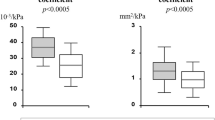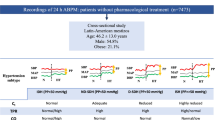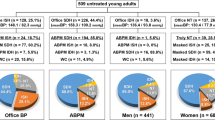Abstract
We sought in this study to examine the effects of diurnal blood pressure variations upon common carotid artery (CCA) elasticity in selected subjects with uncomplicated moderate essential hypertension. Towards this end, 174 non-smoker subjects with stage I-II essential hypertension and without diabetes mellitus, left ventricular hypertrophy and carotid atherosclerosis, were classified as dippers and non-dippers according to the diurnal variation of >10% between mean daytime and night-time systolic and diastolic blood pressure (BP) in 24-h non-invasive ambulatory BP monitoring. CCA distensibility was derived by a combination of surface ultrasonographic data and simultaneous BP measurements at the brachial artery. The dippers and non-dippers were similar with respect to demographic characteristics. Non-dippers had significantly greater office systolic BP, 24-h systolic BP and ambulatory pulse pressure (PP) and significantly less (daytime–night-time) systolic and diastolic BP fall (by 16 mm Hg and 11 mm Hg respectively, P< 0.0001) compared to dippers. cca distensibility was significantly reduced in non-dippers compared to dippers (by 0.89 dyne−1/cm2/10−6, P < 0.05). multiple linear regression analysis identified patient age and ambulatory pp as significant predictors of the cca elasticity index. when patient age, 24-h systolic and diastolic bp were used as covariates in an analysis of covariance, the difference of cca elasticity between dippers and non-dippers ceased to reach statistical significance. in contrast, when patient age, ambulatory pp, systolic (daytime–night-time) bp fall and diastolic (daytime–night-time) bp fall were used as covariates, the difference of cca distensibility between dippers and non-dippers continued to be statistically significant. in conclusion, the excessive impairment of cca elastic properties in non-dippers compared to dippers hypertensive seems to be ascribed to the increased of total 24-h haemodynamic load and not to the circadian pattern of bp.
This is a preview of subscription content, access via your institution
Access options
Subscribe to this journal
Receive 12 digital issues and online access to articles
$119.00 per year
only $9.92 per issue
Buy this article
- Purchase on Springer Link
- Instant access to full article PDF
Prices may be subject to local taxes which are calculated during checkout
Similar content being viewed by others
Author information
Authors and Affiliations
Rights and permissions
About this article
Cite this article
Tsioufis, C., Stefanadis, C., Antoniadis, D. et al. Absence of any significant effects of circadian blood pressure variations on carotid artery elastic properties in essential hypertensive subjects. J Hum Hypertens 14, 813–818 (2000). https://doi.org/10.1038/sj.jhh.1001115
Received:
Revised:
Accepted:
Published:
Issue Date:
DOI: https://doi.org/10.1038/sj.jhh.1001115
Keywords
This article is cited by
-
Long-term effects of multielectrode renal denervation on cardiac adaptations in resistant hypertensive patients with left ventricular hypertrophy
Journal of Human Hypertension (2016)
-
Cross-sectional study of indices of dynamic components of ambulatory blood pressure and cardiac damage in elderly male patients with essential hypertension
Aging Clinical and Experimental Research (2014)
-
Subclinical atherosclerosis and ambulatory blood pressure in children with metabolic syndrome
Pediatric Nephrology (2014)
-
Ambulatory blood pressure and subclinical cardiovascular disease in patients with juvenile-onset systemic lupus erythematosus
Pediatric Nephrology (2013)
-
Association of resistin and adiponectin with different clinical blood pressure phenotypes
Journal of Human Hypertension (2011)



